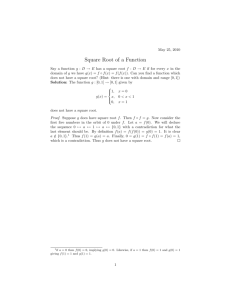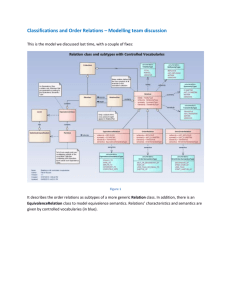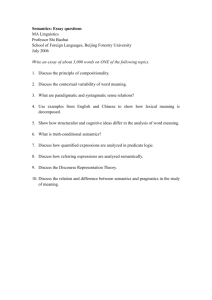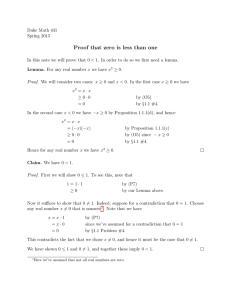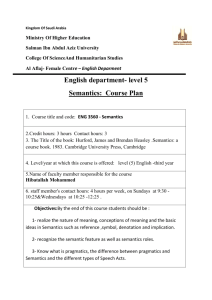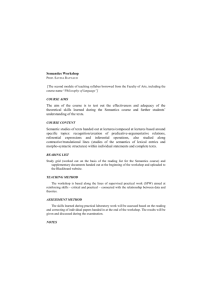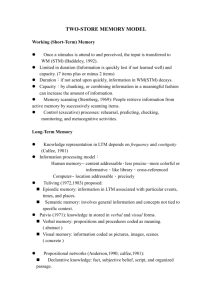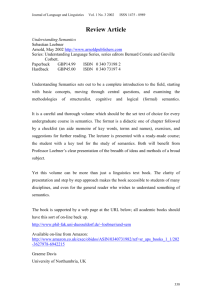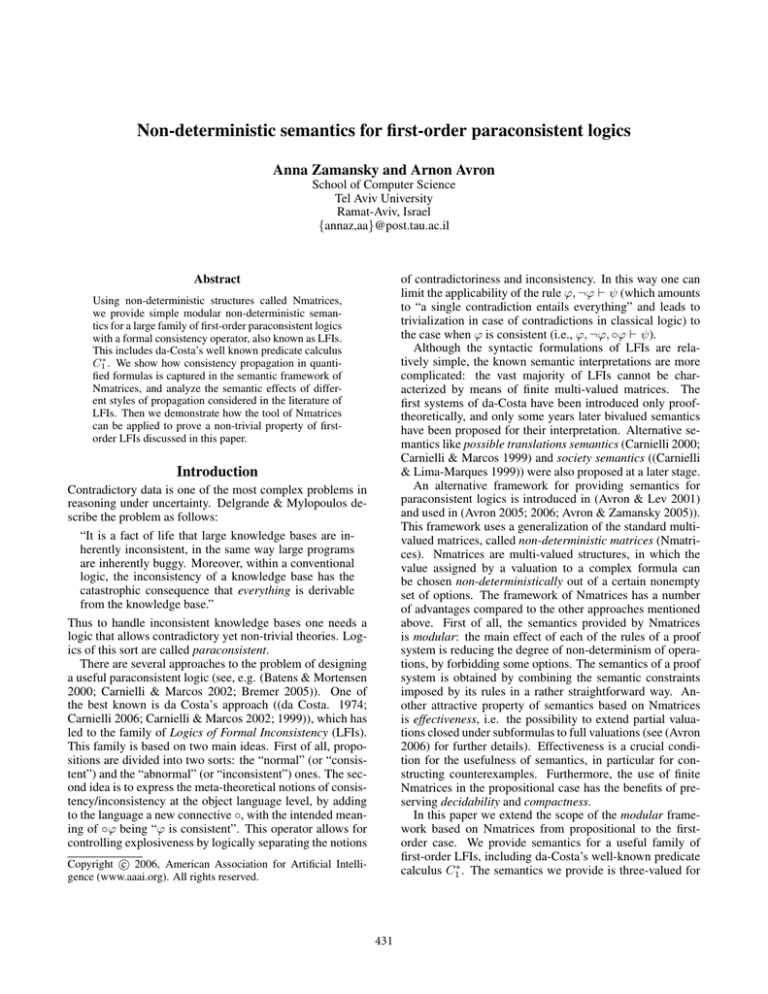
Non-deterministic semantics for first-order paraconsistent logics
Anna Zamansky and Arnon Avron
School of Computer Science
Tel Aviv University
Ramat-Aviv, Israel
{annaz,aa}@post.tau.ac.il
Abstract
of contradictoriness and inconsistency. In this way one can
limit the applicability of the rule ϕ, ¬ϕ ψ (which amounts
to “a single contradiction entails everything” and leads to
trivialization in case of contradictions in classical logic) to
the case when ϕ is consistent (i.e., ϕ, ¬ϕ, ◦ϕ ψ).
Although the syntactic formulations of LFIs are relatively simple, the known semantic interpretations are more
complicated: the vast majority of LFIs cannot be characterized by means of finite multi-valued matrices. The
first systems of da-Costa have been introduced only prooftheoretically, and only some years later bivalued semantics
have been proposed for their interpretation. Alternative semantics like possible translations semantics (Carnielli 2000;
Carnielli & Marcos 1999) and society semantics ((Carnielli
& Lima-Marques 1999)) were also proposed at a later stage.
An alternative framework for providing semantics for
paraconsistent logics is introduced in (Avron & Lev 2001)
and used in (Avron 2005; 2006; Avron & Zamansky 2005)).
This framework uses a generalization of the standard multivalued matrices, called non-deterministic matrices (Nmatrices). Nmatrices are multi-valued structures, in which the
value assigned by a valuation to a complex formula can
be chosen non-deterministically out of a certain nonempty
set of options. The framework of Nmatrices has a number
of advantages compared to the other approaches mentioned
above. First of all, the semantics provided by Nmatrices
is modular: the main effect of each of the rules of a proof
system is reducing the degree of non-determinism of operations, by forbidding some options. The semantics of a proof
system is obtained by combining the semantic constraints
imposed by its rules in a rather straightforward way. Another attractive property of semantics based on Nmatrices
is effectiveness, i.e. the possibility to extend partial valuations closed under subformulas to full valuations (see (Avron
2006) for further details). Effectiveness is a crucial condition for the usefulness of semantics, in particular for constructing counterexamples. Furthermore, the use of finite
Nmatrices in the propositional case has the benefits of preserving decidability and compactness.
In this paper we extend the scope of the modular framework based on Nmatrices from propositional to the firstorder case. We provide semantics for a useful family of
first-order LFIs, including da-Costa’s well-known predicate
calculus C1∗ . The semantics we provide is three-valued for
Using non-deterministic structures called Nmatrices,
we provide simple modular non-deterministic semantics for a large family of first-order paraconsistent logics
with a formal consistency operator, also known as LFIs.
This includes da-Costa’s well known predicate calculus
C1∗ . We show how consistency propagation in quantified formulas is captured in the semantic framework of
Nmatrices, and analyze the semantic effects of different styles of propagation considered in the literature of
LFIs. Then we demonstrate how the tool of Nmatrices
can be applied to prove a non-trivial property of firstorder LFIs discussed in this paper.
Introduction
Contradictory data is one of the most complex problems in
reasoning under uncertainty. Delgrande & Mylopoulos describe the problem as follows:
“It is a fact of life that large knowledge bases are inherently inconsistent, in the same way large programs
are inherently buggy. Moreover, within a conventional
logic, the inconsistency of a knowledge base has the
catastrophic consequence that everything is derivable
from the knowledge base.”
Thus to handle inconsistent knowledge bases one needs a
logic that allows contradictory yet non-trivial theories. Logics of this sort are called paraconsistent.
There are several approaches to the problem of designing
a useful paraconsistent logic (see, e.g. (Batens & Mortensen
2000; Carnielli & Marcos 2002; Bremer 2005)). One of
the best known is da Costa’s approach ((da Costa. 1974;
Carnielli 2006; Carnielli & Marcos 2002; 1999)), which has
led to the family of Logics of Formal Inconsistency (LFIs).
This family is based on two main ideas. First of all, propositions are divided into two sorts: the “normal” (or “consistent”) and the “abnormal” (or “inconsistent”) ones. The second idea is to express the meta-theoretical notions of consistency/inconsistency at the object language level, by adding
to the language a new connective ◦, with the intended meaning of ◦ϕ being “ϕ is consistent”. This operator allows for
controlling explosiveness by logically separating the notions
c 2006, American Association for Artificial IntelliCopyright gence (www.aaai.org). All rights reserved.
431
We usually denote a system B[X] by Bs, where s is a string
consisting of the names of the schemata from X. For instance, Bia denotes the system B[{(i), (a)}].
Remark: The difference between Bcial and da-Costa’s original formulation of C1 (see (da Costa. 1974)) is that the
connective ◦ in C1 was not taken as primitive, but ◦ψ was
instead denoted ψ ◦ and was taken as an abbreviation of
¬(ψ ∧ ¬ψ) (see (Carnielli 2006; Avron 2006) for further
details).
most of the systems, and infinite-valued for the rest of them.
We also demonstrate how consistency propagation in quantified formulas is captured in the extended framework, by
analyzing the semantic effects of various consistency propagation schemata. Finally, the semantic tool of Nmatrices
is applied to prove a proof-theoretical property of some of
the discussed LFIs, namely that two sentences are logically
indistinguishable (i.e., intersubstitutable in any context) iff
they are identical up to the names of their bound variables
and deletion/addition of void quantifiers. This is closely
connected to an important result of Mortensen ((Mortensen
1980; Carnielli & Marcos 2002)) on algebraization of C1 .
Non-deterministic matrices
Our main semantic tool in what follows will be the following
generalization of the concept of a multi-valued matrix given
in (Avron & Lev 2001; Avron 2005; Avron & Zamansky
2005).
Definition 4 (Non-deterministic
matrix)
A
nondeterministic matrix (Nmatrix) for L is a tuple
M = V, D, O, where: V is a non-empty set of truth
values, D (designated truth values) is a non-empty proper
subset of V and O includes the following interpretation
functions:
• ˜
M : V n → P + (V) for every n-ary connective .
• Q̃M : P + (V) → P + (V) for every quantifier Q.
Preliminaries
In what follows L is a first-order language including the connectives ∧, ∨, →, ¬, ◦. The set F rmL of its formulas is defined standardly. Denote by F rmcl
L the set of closed formulas (sentences) of L and by T rmcl
L - its set of closed terms.
Denote by F v[ψ] (F v[t]) the set of variables occurring free
in a formula ψ (a term t). Denote by ψ{t/x} the formula
obtained from ψ by substituting the term t for every free occurrence of x in ψ. A term t is free for x in ψ if either ψ is
atomic, ψ = (ψ1 , ..., ψn ) and t is free for x in ψ1 , ..., ψn ,
or ψ = Qyϕ and either x = y or y ∈ F v[t] and t is free for
x in ϕ.
Given a set A, denote by P + (A) the set of all non-empty
subsets of A.
Definition 5 (L-structure) Let M be an Nmatrix. An Lstructure for M is a pair S = D, I where D is a (nonempty) domain and I is a function interpreting constants,
predicate symbols and function symbols of L, satisfying the
following conditions: I[c] ∈ D, I[pn ] : Dn → V is an n-ary
predicate, and I[f n ] : Dn → D is an n-ary function.
I is extended to interpret closed terms of L as follows:
A taxonomy of LFIs
Let HCL+ be some standard propositional Hilbert-type system with MP as the only rule of inference which is sound and
complete for the positive fragment of classical propositional
logic.
I[f (t1 , ..., tn )] = I[f ][I[t1 ], ..., I[tn ]]
Henceforth we will be interested in a special kind of Lstructures, called Henkin L-structures (see e.g.(Leblanc
2001)), satisfying that for every element of the domain there
is a closed L-term referring to it. The results presented
below can be easily generalized to general L-structures by
adding a set of individual constants {a | a ∈ D} to the language (see (Avron & Zamansky 2005) for further details).
In first-order logic we expect certain classes of formulas to be always assigned the same truth values. Examples of such classes are formulas which are identical up to
the names of their bound variables, or formulas obtained by
deletion/addition of void quantifiers, i.e. quantifiers that do
not bind any variables, and are in fact redundant. In order
to guarantee that the same truth values are chosen for such
formulas, we define the relation ∼vα on formulas:
Definition 1 (The system B) B1 is the system obtained
from HCL+ by the addition of the following schemata:
(t) ¬ϕ ∨ ϕ
(p) ◦ ϕ → ((ϕ ∧ ¬ϕ) → ψ)
Definition 2 (The set of schemata SC) Let SC be the set
consisting of the following schemata:
(c) ¬¬ϕ → ϕ
(e) ϕ → ¬¬ϕ
(i) ¬ ◦ ϕ → (ϕ ∧ ¬ϕ)
(l) ¬(ϕ ∧ ¬ϕ) → ◦ϕ
(d) ¬(¬ϕ ∧ ϕ) → ◦ϕ
(b) ¬(ϕ ∧ ¬ϕ) ∨ (¬ϕ ∧ ϕ)) → ◦ϕ
for ∈ {∨, ∧, →}:
(a ) ◦ϕ ∧ ◦ψ → ◦(ϕ ψ)
(o ) ◦ϕ ∨ ◦ψ → ◦(ϕ ψ)
Definition 6 (∼vα ) Let ψ, ψ be L-formulas. ψ ∼vα ψ if ψ can be obtained from ψ by renaming of bound variables and
deletions/additions of void quantifiers.
Note that (d) and (l) are not equivalent in this context, as will
be explained in the sequel.
It is easy to see that ∼vα is an equivalence relation.
Definition 7 (S-valuation) Let S = D, I be an Lstructure for an Nmatrix M. An S-valuation v : F rmcl
L →
V is legal in M if it satisfies the following conditions:
• v respects the relation ∼vα , i.e. v[ψ] = v[ψ ] for every two
L-sentences ψ, ψ , such that ψ ∼α
v ψ .
Definition 3 (B[X]) For X ⊆ SC, B[X] is the system obtained from B by adding the schemata from X.
We write Γ B[X] ψ if ψ is provable from Γ in B[X].
1
The system B is called mbC in (Carnielli 2006).
432
• v[p(t1 , ..., tn )] = I[p][I[t1 ], ..., I[tn ]].
• v[(ψ1 , ..., ψn )] ∈ ˜
M [v[ψ1 ], ..., v[ψn ]].
• v[Qxψ] ∈ Q̃M [{v[ψ{t/x}] | t ∈ T rmcl
L }].
b =
a∧
F
¬
a = T
D
Definition 8 (Model, M-validity, M ) Let S = D, I be
an L-structure for an Nmatrix M, ψ a sentence of L(D) and
Γ, ∆ sets of formulas of L(D).
1. An M-legal S-valuation v is a model of a sentence ψ
(a set of sentence Γ) in M, denoted by S, v |=M ψ
(S, v |=M Γ), if v[ψ] ∈ D (v[ψ] ∈ D for every ψ ∈ Γ).
2. The consequence relation M between sets of Lsentences is defined as follows: Γ M ∆ if for every Lstructure S and every M-legal S-valuation v: S, v |=M
Γ implies that there is some ψ ∈ ∆, such that S, v |=M ψ.
3. An Nmatrix M is sound for a system C if C ⊆M . An
Nmatrix M is complete for a system C if M ⊆C .
F
D
either a ∈ F or b ∈ F
otherwise
a∈T
a∈F
a∈I
V
◦a =
F
a∈F ∪T
a∈I
A B-Nmatrix is an Nmatrix which is a refinement of some
basic B-Nmatrix.
MB is the 3-valued basic B-Nmatrix with T = {t}, F =
{f } and I = {I}.
It is shown in (Avron 2006) that B is sound for any basic BNmatrix and MB is a characteristic Nmatrix for B. As for
the rest of the systems defined above, each of the schemata
(i), (c), (e), (a ), (o ) imposes some semantic condition on
the basic Nmatrix.
Definition 11 (Refining conditions for SC) The refining
conditions for the schemata from SC are:
The following definition and proposition are a straightforward extension of defn. 3 and proposition 1 from (Avron
2006):
Definition 9 (Refinement) Let M1 = V1 , D1 , O1 and
M2 = V2 , D2 , O2 be Nmatrices for L. M2 is a refinement of M1 if V2 ⊆ V1 , D2 = D1 ∩ V2 , ˜
M2 [a1 , ..., an ] ⊆
˜M1 [a1 , ...an ] for every n-ary connective of L and every
a1 , ..., an ∈ V2 and Q̃M2 [H] ⊆ Q̃M1 [H] for every quantifier Q of L and every H ⊆ V2 .
˜[a] ⊆ T .
Cond(i) : a ∈ T ∪ F ⇒ ◦
Cond(c) : a ∈ F ⇒ ¬
˜ [a] ⊆ T .
Cond(e) : a ∈ I ⇒ ¬
˜ [a] ⊆ I.
Cond(a ) : a ∈ T ∪ F and b ∈ T ∪ F ⇒ ˜
[a, b] ⊆ T ∪ F.
Cond(o ) : a ∈ T ∪ F or b ∈ T ∪ F ⇒ ˜
[a, b] ⊆ T ∪ F.
Definition 12 (The set S)
Let S = {i, c, e, ce, cie, ia, cia, iae, ciae, io, ioe, cioe}.
Proposition 1 If M2 is a refinement of M1 , then
M1 ⊆M2 .
Remark: Note that systems which include the schema (a ),
or the schema (o ), but not the schema (i) are not considered here for the sake of a simpler presentation: nondeterministic semantics for such systems require five truth
values rather than three. A completely modular five-valued
semantics is provided for such systems in (Avron 2005).
Now we come to the semantics of (Avron 2006) for the
propositional systems presented above. Recall that the idea
of LFIs is to divide the propositions into “consistent” and
“inconsistent” and to limit the applicability of the inference
ψ, ¬ψ ϕ (which amounts to “a single contradiction entails
everything”) to the case where ψ is “consistent” (expressing
the assumption of its consistency within the language using
the operator ◦). This is reflected in the use of sets of “consistent” and “inconsistent” truth values: T is the set of designated “consistent” truth values, F - the set of non-designated
“consistent” truth values and I - the set of “inconsistent”
truth values (in this paper we only consider the cases when
the “inconsistent” truth values are all designated). The intuitive meaning of this is that if a proposition ψ is assigned
a truth value from T (meaning that ψ is “consistently true”
and so its negation is “false”), then ¬ψ is assigned a truth
value from F. If ψ is assigned a truth value from I, then
¬ψ is also assigned a truth value from I (meaning that ψ is
“inconsistently true”, and so both ψ and ¬ψ can be “true” at
the same time).
Definition 10 (Basic B-Nmatrix, B-Nmatrix) A basic BNmatrix is an Nmatrix M = V, D, O, such that V = T ∪
I ∪ F, where T , I, F are non-empty disjoint sets, D = T ∪
I, and O is defined by:
D either a ∈ D or b ∈ D
b =
a∨
F otherwise
D either a ∈ F or b ∈ D
a
→b =
F otherwise
Definition 13 (MBs ) For s ∈ S, MBs is the unique BNmatrix in which V = {t}, F = {f } and I = {I} and
which satisfies Cond(x) for every x occurring in s.
Theorem 1 (Avron 2006) For every s ∈ S, MBs is a characteristic Nmatrix for Bs.
Next (Avron 2006) defines a infinite-valued nondeterministic semantics for systems containing the schemata
(l), (d) and (d) and shows that no finite-valued semantics
exists for them:
Definition 14 (MBl , MBd , MBb ) Let T = {tji | i ≥
0, j ≥ 0}, I = {Iij | i ≥ 0, j ≥ 0}, F = {f }. The
Nmatrix MBl = V, D, O for L is defined as follows:
V = T ∪ I ∪ F, D = T ∪ I and O is defined by:
D if either a ∈ D or b ∈ D
a∨b =
F if a, b ∈ F
D if either a ∈ F or b ∈ D
a
→b =
F if a ∈ D and b ∈ F
F if either a ∈ F or b ∈ F
b = T if a = Iij and b ∈ {Iij+1 , tj+1
a∧
}
i
D otherwise
433
if a ∈ T
F
¬
a = D
a∈F
j+1 j+1
{Ii , ti } if a = Iij
D if a ∈ T ∪ F
◦a =
F if a ∈ I
The Nmatrix MBd
defined as follows:
F
b = T
a∧
D
The Nmatrix MBb
fined as follows:
F
T
b =
a∧
D
It is important to note that unlike in classical predicate
logic, the (vα )-schema is not derivable from the rest of the
schemata of Bf and so has to be added explicitly. For instance, ¬∀xp(x) → ¬∀yp(y) and ¬∀xp(c) → ¬p(c) are
not derivable without it.
Definition 17 (Basic Bf -Nmatrix, Bf -Nmatrix, MfB ) A
basic Bf -Nmatrix M = V, D, O for L is defined similarly
to a basic B-Nmatrix (defn. 10), with the addition of the following interpretations of quantifiers for every H ⊆ P + (V):
D if H ⊆ D
∀[H] =
F otherwise
D if H ∩ D = ∅
∃[H] =
F otherwise
is
is defined like MBl , except that ∧
if either a ∈ F or b ∈ F
if b = Iij and a ∈ {Iij+1 , tj+1
}
i
otherwise
is deis defined like MBl , except that ∧
A Bf -Nmatrix is any refinement of a basic Bf -Nmatrix.
if either a ∈ F or b ∈ F
(if a = Iij and b ∈ {Iij+1 , tj+1
})
i
j
j+1 j+1
or(b = Ii and a ∈ {Ii , ti })
otherwise
The Nmatrix MfB for L is the 3-valued basic Bf -Nmatrix
with T = {t}, F = {f } and I = {I}.
Theorem 3 Let Γ be a set of L-sentences and µ - an Lsentence. Then Γ Bf µ iff Γ Mf µ.
Definition 15 (MBsz ) For z ∈ {l, d, b} and s ∈ S, MBsz
is the weakest refinement of MBz which satisfies Cond(x)
for every x occurring in s. In other words, MBsz is obtained from MBz by the following modifications:
˜[a] = T .
1. If i occurs in s, then for every a ∈ F ∪ T , ◦
2. If c occurs in s, then ¬
˜ [f ] = T .
B
Proof: The proof of soundness is not hard and is left for the
reader.
For completeness, suppose that Γ Bf µ. We will construct
an L-structure S and an M-legal S-valuation v, refuting
Γ Mf µ, that is S, v |=Mf Γ, but S, v|=Mf µ.
B
B
B
It is easy to see that we can restrict ourselves to Lr , the subset of L consisting of all the constants, function and predicate symbols occurring in Γ ∪ {µ}. Let L be the language obtained from Lr by adding a countably infinite set
of new constants. It is a standard matter to show that Γ can
be extended to a maximal set Γ∗ , such that Γ∗ Bf µ over L ,
satisfying:
3. If e occurs in s, then ¬
˜ [Iij ] = {Iij+1 }.
˜ [a, b] =
4. If a∧ occurs in s, then: for a ∈ T and b ∈ T : ∧
T . If a∨ occurs in s, then: for a ∈ T and b ∈ I, or b ∈ T
˜ [a, b] = T . If a→ occurs in s, then: for
and a ∈ I: ∨
a ∈ F and b ∈ I, or b ∈ T and a ∈ I: →[a,
˜
b] = T .
Similarly for (o ).
Theorem 2 ((Avron 2006)) For z ∈ {l, d, b} and s ∈ S,
MBsz is a characteristic Nmatrix for Bsz.
1. Γ ⊆ Γ∗ .
2. For every sentence ∃xψ ∈ Γ∗ there is a constant cψ such
that ψ{cψ /x} ∈ Γ∗ .
3. For every sentence ∀xψ ∈ Γ∗ there is a constant cψ such
that ψ{cψ /x} ∈ Γ∗ .
Semantics for first-order LFIs
Systems with 3-valued semantics
Definition 16 (The system Bf ) Bf is the first-order system
obtained from B by the addition of the following schemata:
Let ψ, ϕ, ∀xA be L -sentences. It is easy to show that Γ∗
satisfies the following properties:
1. ψ ∈ Γ∗ iff ψ → µ ∈ Γ∗ .
2. If ψ ∈ Γ∗ , then ψ → ϕ ∈ Γ∗ .
3. ψ ∨ ϕ ∈ Γ∗ iff either ϕ ∈ Γ∗ or ψ ∈ Γ∗ .
4. ψ ∧ ϕ ∈ Γ∗ iff both ϕ ∈ Γ∗ and ψ ∈ Γ∗ .
5. ϕ → ψ ∈ Γ∗ iff either ϕ ∈ Γ∗ or ψ ∈ Γ∗ .
6. Either ψ ∈ Γ∗ or ¬ψ ∈ Γ∗ .
7. If ψ and ¬ψ are both in Γ∗ , then ◦ψ ∈ Γ∗ .
8. If ψ ∈ Γ∗ , then for every L -sentence ψ such that
ψ ∼vα ψ: ψ ∈ Γ∗ .
9. If ∀xA ∈ Γ∗ , then for every closed L -term t: A{t/x} ∈
Γ∗ . If ∀xA ∈ Γ∗ , then there is some constant cA of L ,
such that A{cA /x} ∈ Γ∗ .
(vα ) ψ → ψ f or ψ ∼vα ψ (∀f ) ∀xψ → ψ{t/x}
(∃t ) ψ{t/x} → ∃xψ
and the following inference rules:
(ϕ → ψ)
(∀t ) (ϕ → ∀xψ)
(ψ → ϕ)
(∃f ) (∃xψ → ϕ)
where t is free for x in ψ and x ∈ F v[ϕ].
434
S, v|=Mf µ.
B
Now we handle the various extensions of the basic system
Bf by the combinations of propositional schemata from S
(see defn. 12).
10. If ∃xA ∈ Γ∗ , then there is some constant cA of L, such
that A{cA /x} ∈ Γ∗ . If ∃xA ∈ Γ∗ , then for every closed
term t of L : A{t/x} ∈ Γ∗ .
The L -structure S = D, I is defined as follows:
• D is the set of all the closed terms of L .
• For every constant c of L : I[c] = c.
• For every t1 , ..., tn ∈ D: I[f ][t1 , ..., tn ] = f (t1 , ..., tn ).
• For every t1 , ..., tn ∈ D:
f p(t1 , ..., tn ) ∈ Γ∗
t ¬p(t1 , ..., tn ) ∈ Γ∗
I[p][t1 , ..., tn =
I p(t1 , ..., tn ) ∈ Γ∗
and ¬p(t1 , ..., tn ) ∈ Γ∗
Definition 18 (Bf s) For s ∈ S, the system Bf s is obtained
from Bf by adding the schemata in s.
Definition 19 (MfBs ) For s ∈ S, MfBs is the Bf -Nmatrix
which satisfies Cond(x) for every x occurring in s.
Theorem 4 Let Γ be a set of L-sentences and µ - an Lsentence. For any s ∈ S, Γ Bs µ iff Γ Mf µ.
Bs
Proof: The proof of soundness is not hard and is left to the
reader. The proof of completeness is similar to the proof
of theorem 3. It remains to show that the new conditions
imposed by the schemata in s are respected by the valuation
v. The proof is similar to the proof in (Avron 2006) (see
theorem 3).
Next we define the refuting S-valuation v as follows:
∗
f ψ ∈ Γ
v[ψ] = t ¬ψ ∈ Γ∗
I ψ ∈ Γ∗ and ¬ψ ∈ Γ∗
Consistency propagation for quantifiers
Next we focus on consistency propagation in quantified formulas and analyze the semantic effects of different styles of
propagation. First recall the two propositional schemata for
consistency propagation discussed above:
Note that by property 6 v is well-defined. We still need to
show that v is legal in MfB .
Let ψ, ψ be two L -sentences, such that ψ ∼vα ψ . Then by
property 8 and since ∼vα is symmetric, ψ ∈ Γ∗ iff ψ ∈ Γ∗ .
Also, ¬ψ ∼vα ¬ψ and again by property 8 ¬ψ ∈ Γ∗ iff
¬ψ ∈ Γ∗ . Thus v[ψ] = v[ψ ] and so v respects the ∼vα relation. It remains to show that v respects the interpretations
of the connectives and quantifiers in MfB . The proof for
propositional connectives is similar to the proof in (Avron
2006). We show the proof for ∀ and ∃:
• Let ∀xψ be an L -sentence, such that f
∈
{v[ψ{t/x}] | t ∈ T rmcl
Denote the set
L }.
Suppose by
{v[ψ{t/x}] | t ∈ T rmcl
L } by Hψ .
contradiction that v[∀xψ] = t or v[∀xψ] = I. If the latter
holds, by definition of v, ∀xψ ∈ Γ∗ . If the former holds,
¬∀xψ ∈ Γ∗ and by property 6, again ∀xψ ∈ Γ∗ . By
property 9, for every closed L -term t: ψ{t/x} ∈ Γ∗ and
so v[ψ{t/x}] = f , in contradiction to our assumption.
• Let ∀xψ be an L -sentence, such that f ∈ Hψ . Suppose
by contradiction that v[∀xψ] = f . Then by definition of
v, ∀xψ ∈ Γ∗ . By property 10, there is some closed L term t, such that ψ{t/x} ∈ Γ∗ . Then v[ψ{t/x}] = f , in
contradiction to our assumption.
• Let ∃xψ be an L -sentence, such that D ∩ Hψ = ∅. Suppose by contradiction that v[∃xψ] = f . Then ∃xψ ∈ Γ∗ .
By property 10, for every closed L -term t: ψ{t/x} ∈ Γ∗ ,
and so v[ψ{t/x}] = f , in contradiction to our assumption.
• Let ∃xψ be an L -sentence, such that D ∩ Hψ = ∅. Suppose by contradiction that v[∃xψ] ∈ D. Then ∃xψ ∈ Γ∗
and by property 10, there is some closed term t, such that
ψ{t/x} ∈ Γ∗ . Then v[{t/x}] ∈ D, in contradiction to
our assumption.
It is easy to see that for every L -sentence ψ: v[ψ] ∈ D
iff ψ ∈ Γ∗ . So S, v |=Mf Γ (recall that Γ ⊆ Γ∗ ), but
for ∈ {∨, ∧, →}:
(a ) ◦ϕ ∧ ◦ψ → ◦(ϕ ψ)
(o ) ◦ϕ ∨ ◦ψ → ◦(ϕ ψ)
In (a ) the consistency of both ψ and ϕ implies the consistency of ψ ϕ. In (o ) the consistency of one of the
sentences ψ, ϕ implies the consistency of ψ ϕ. In order to generalize the above schemata to quantified formulas,
we can think of a universally (existentially) quantified formula as a “conjunction” (“disjunction”) of all of its substitution instances. Then we get the following quantificational
schemata (some of them have already been considered in the
literature of LFIs, see e.g. (Carnielli 2006)):
(a∀ ) :
(a∃ ) :
(o∀ ) :
(o∃ ) :
∀x ◦ ψ → ◦∀xψ
∀x ◦ ψ → ◦∃xψ
∃x ◦ ψ → ◦∀xψ
∃x ◦ ψ → ◦∃xψ
Like in the propositional case, we do not consider here systems which include the schemata (aQ ) or (oQ ) for Q∈
{∀, ∃}, but not the schema (i).2 The schemata (aQ )3 and
(oQ ) for Q ∈ {∀, ∃} are a generalization of the (a ) and (o )
propagation schemata respectively. (aQ ) implies that the
consistency of a quantified formula follows from the consistency of all of its substitution instances. (oQ ) implies
that the consistency of a quantified formula follows from the
consistency of at least one of its substitution instances.
We can also consider other variations of quantificational
propagation:
2
Similarly to the propositional case, five-valued modular semantics can be defined for such first-order systems.
3
(a∀ ) and (a∀ ) are included in da-Costa’s predicate calculus
C1∗ , as will be explained in the next subsection.
B
435
(w∀ ) : ◦∀xψ → ∀x ◦ ψ
(w∃ ) : ◦∃xψ → ∀x ◦ ψ
(r∀ ) : ◦∀xψ → ∃x ◦ ψ
(r∃ ) : ◦∃xψ → ∃x ◦ ψ
(wQ ) implies that from the consistency of the quantified formula follows the consistency of all of the substitution instances. (rQ ) implies that from the consistency of the quantified formula, follows the consistency of at least one of its
substitution instances.
Definition 20 Let PR={a∀ , a∃ , o∀ , o∃ , r∀ , r∃ , w∃ }.
Definition 21 The refining conditions induced by the above
schemata are:
˜
Cond(a∀ ) : H ⊆ T ∪ F ⇒ ∀[H]
⊆T ∪F
˜
Cond(a∃ ) : H ⊆ T ∪ F ⇒ ∃[H]
⊆T ∪F
˜
Cond(o∀ ) : H ∩ (T ∪ F) = ∅ ⇒ ∀[H]
⊆T ∪F
˜
Cond(o∃ ) : H ∩ (T ∪ F) = ∅ ⇒ ∃[H]
⊆T ∪F
˜
Cond(w∀ ) : H ∩ I = ∅ ⇒ ∀[H] ⊆ I
˜
Cond(w∃ ) : H ∩ I = ∅ ⇒ ∃[H]
⊆I
˜
Cond(r∀ ) : H ⊆ I ⇒ ∀[H] ⊆ I
˜
Cond(r∃ ) : H ⊆ I ⇒ ∃[H]
⊆I
that for every closed L-term t, v[◦ψ{t/x}] ∈ F and thus
˜
v[◦ψ{t/x}] ∈ I. If for every H, such that H ⊆ I: ∀[H]
⊆
I, then it would not be possible to choose v[◦∀xψ] ∈ D.
Similarly for the case of (r∃ ).
Definition 22 (Bf s[P]) For s ∈ S and P ⊆ P R, let
Bf s[P ] be the system obtained from Bf s by adding the
schemata in P .
Definition 23 (MfBs [P]) For s ∈ S and P ⊆ P R, let
MfBs [P ] be the refinement of MfBs , which satisfies the refining conditions of the schemata from P .
Theorem 5 Let P ⊆ P R and s ∈ S, such that i ∈ s.
Let Γ be a set of L-sentences and µ - an L-sentence. Then
Γ Bs[P ] µ iff Γ Mf [P ] µ.
Bs
Proof: a straightforward modification of the proof of theorem 3. We only have to check that the conditions imposed by
the schemata in P are respected by the valuation v defined
in the proof.
• Suppose that a∀ ∈ s and let ∀xψ be an L-sentence, such
that Hψ = {v[ψ{t/x}] | t ∈ T rmcl
L } ⊆ V ∪ F. Suppose
by contradiction that v[∀xψ] = I. Then, by definition of
v, ∀xψ ∈ Γ∗ and ¬∀xψ ∈ Γ∗ . By property 7, ◦∀xψ ∈
Γ∗ . By the schema (a∀ ), ∀x ◦ ψ ∈ Γ∗ . By property
9, there is some closed L -term t, such that ◦ψ{t/x} ∈
Γ∗ . By property 6, ¬ ◦ ψ{t/x} ∈ Γ∗ . By schema (i)
and property 4, ψ{t/x} ∈ Γ∗ and ¬ψ{t/x} ∈ Γ∗ and so
v[ψ{t/x}] = I, in contradiction to our assumption.
• The proof for (a∃ ) is similar to the previous case.
• Suppose that o∀ ∈ s and let ∀xψ be an L-sentence,
such that Hψ ∩ (V ∪ F ) = ∅. Suppose by contradiction
that v[∀xψ] = I. Then, by definition of v, ∀xψ ∈ Γ∗
and ¬∀xψ ∈ Γ∗ . By property 7, ◦∀xψ ∈ Γ∗ . By
the schema (o∀ ), ∃x ◦ ψ ∈ Γ∗ . By property 9, for
every closed L -term t: ◦ψ{t/x} ∈ Γ∗ . By property
6, ¬ ◦ ψ{t/x} ∈ Γ∗ . By schema (i) and property 4,
ψ{t/x} ∈ Γ∗ and ¬ψ{t/x} ∈ Γ∗ . Hence, for every
closed L -term t: v[ψ{t/x}] = I, in contradiction to our
assumption. The proof for (o∃ ) is similar to the previous
case.
• Suppose that w∃ ∈ s and let ∃xψ be an L-sentence, such
that Hψ ∩ I = ∅. Suppose by contradiction that v[∃xψ] ∈
I. Then either ∃xψ ∈ Γ∗ , or ¬∃xψ ∈ Γ∗ . Either way,
by property 4, ∃xψ ∧ ¬∃xψ ∈ Γ∗ . By the schema (i),
¬ ◦ ∃xψ ∈ Γ∗ . By property 6, ◦∃xψ ∈ Γ∗ . By the
schema (w∃ ), ∀x ◦ ψ ∈ Γ∗ . By property 9, for every
closed L -term t: ◦ψ{t/x} ∈ Γ∗ . By property 7, every
closed L -term t: either ψ{t/x} ∈ Γ∗ , or ¬ψ{t/x} ∈ Γ∗ .
Hence for every closed L -term t: either v[ψ{t/x}] ∈ T
or v[ψ{t/x}] ∈ F, in contradiction to our assumption.
• Suppose that r∀ ∈ s and let ∀xψ be an L-sentence, such
that Hψ ⊆ I. Suppose by contradiction that v[∀xψ] ∈
I. Then either ∀xψ ∈ Γ∗ , or ¬∀xψ ∈ Γ∗ . Either way,
by property 4, ∀xψ ∧ ¬∀xψ ∈ Γ∗ . By the schema (i),
¬◦∀xψ ∈ Γ∗ . By property 6, ◦∀xψ ∈ Γ∗ . By the schema
(r∀ ), ∃x◦ψ ∈ Γ∗ . By property 9, there is some closed L term t: ◦ψ{t/x} ∈ Γ∗ . By property 7, either ψ{t/x} ∈
Remark: Note that we do not include (w∀ ) in P R. The
reason for this is that no refinement M of MBf can satisfy
˜M [{f, I}] would then be an empty set!
Cond(w∀ ), since ∀
For simplicity of presentation, we do not consider here systems including this schema (in order to provide semantics
for such systems, at least one non-designated “inconsistent”
truth-value needs to be added).
Now let us explain how the above conditions are derived. A
refutation of (a∀ ) ∀x ◦ ψ → ◦∀xψ would be a valuation v,
such that v[◦∀xψ] ∈ F, but v[∀x ◦ ψ] ∈ D. v[∀x ◦ ψ] ∈ D
implies that for every closed term t: v[◦ψ{t/x}] ∈ D. Then
Hψ = {v[ψ{t/x}] t ∈ T rmcl
L } ⊆ T ∪ F. Also, since
v[◦∀xψ] ∈ F, v[∀xψ]) ∈ I. This will be impossible if
˜ ψ ] ⊆ T ∪ F, and so v[∀xψ] ∈ F ∪ T and v[◦∀xψ] ∈ D.
∀[H
Similarly for the case of (a∃ ).
A refutation of (o∀ ) ∃x◦ψ → ◦∀xψ would be a valuation v,
such that v[◦∀xψ] ∈ F, and v[∃x ◦ ψ] ∈ D. This means that
there is some closed term t, such that v[ψ{t/x}] ∈ V ∪ F. If
˜
for every H ⊆ V, such that H ∩(V ∪F) = ∅: ∀[H]
⊆ V ∪F,
v[∀xψ] ∈ I and so v[◦∀xψ] ∈ F. Similarly for the case of
(o∃ ).
A refutation of (w∀ ) ◦∀xψ → ∀x ◦ ψ would be a valuation
v, such that v[◦∀xψ] ∈ D, but v[∀x ◦ ψ] ∈ F. It means
that for some closed L-term t, v[◦ψ{t/x}] ∈ F and thus
˜
v[◦ψ{t/x}] ∈ I. If for every H, such that I ∈ H: ∀[H]
⊆
I, then it would not be possible to choose v[◦∀xψ] ∈ D.
Recall, however, that in the three-valued Nmatrix MfB , for
˜
H = {f, I}: ∀[H]
⊆ F, and so the above condition cannot
f
hold in MB or any of its refinements. This problem does not
arise in the case of (w∃ ), since the requirement that H ⊆ I
˜
implies ∃[H]
⊆ I is compatible with the interpretation of ∃
f
in MB .
A refutation of (r∀ ) ◦∀xψ → ∃x ◦ ψ would be a valuation
v, such that v[◦∀xψ] ∈ D, but v[∃x ◦ ψ] ∈ F. It means
436
Γ∗ , or ¬ψ{t/x} ∈ Γ∗ . Hence either v[ψ{t/x}] ∈ T or
v[ψ{t/x}] ∈ F, in contradiction to our assumption. The
proof for (r∃ ) is similar to the previous case.
Proof: a simple adaptation of the proof of theorem 6.
For instance, consider the system Bf cial[{(a∀ ), (a∃ )]
equivalent4 to da-Costa’s predicate calculus C1∗ ((da Costa.
1974)). It includes the schemata of C1 , (∀t ), (∀f ), (∃t ),
(∃f ), (a∀ ) and (a∃ ). Also, if A and B are α-equivalent, or
one is obtained from the other by the suppression of void
quantifiers, then A → B and B → A are axioms of C1∗ (this
is captured by the (vα ) axiom).
The Nmatrix MfBcial[{(a∀ ),(a∃ )}] is defined similarly to
MBcial , with the addition of the following interpretation
functions:
T if H ⊆ T
∀[H] = F if H ∩ F = ∅
D otherwise
T if H ∩ T = ∅ and H ⊆ (T ∪ F)
∃[H] = F if H ⊆ F
D otherwise
Note how the modularity of the semantic framework of
Nmatrices allows for a flexible control of the consistency
propagation: one can choose different propagation styles for
different quantifiers.
Systems with infinitely-valued semantics
Now we handle first-order extensions of systems including
the schemata (l), (d) and (b). Again, for z ∈ {l, d, b}, s ∈ S
and P ⊆ P R, the systems Bf z, Bf sz and Bf sz[P ] are
defined as before.
Definition 24 (MfBz ) The Nmatrix MfBz where z ∈
{l, d, b} for L is defined like the Nmatrix MBz (defn. 14)
with the addition of the following interpretations of quantifiers for every H ⊆ P + (V):
D if H ⊆ D
∀[H] =
F otherwise
∃[H] =
where:
D
F
Using the above Nmatrix, it is easy to semantically verify
the following theorem of da Costa.:
Theorem 8 ((da Costa. 1974))
if H ∩ D = ∅
otherwise
C1∗ ¬∃x¬A(x) ↔ ∀xA(x)
C1∗ ¬∀x¬A(x) ↔ ∃xA(x)
C1∗ ¬∃xA(x) ↔ ∀x¬A(x)
C1∗ ∃x¬A(x) ↔ ¬∀xA(x)
F = {f }, D = {tji | i ≥ 0, j ≥ 0} ∪ {Iij | i ≥ 0, j ≥ 0}
Let us show for the first case. It is easy to see that an Lstructure S and an MfBcial[{(a∀ ),(a∃ )}] -legal S-valuation v
can be defined, which satisfies:
Theorem 6 Let Γ be a set of L -sentences and µ - an L sentence. For z ∈ {l, d, b}: Γ Bfz µ iff Γ Mf µ.
Bz
Proof: An simple generalization of the proof of (Avron
2006) for the propositional case.
• For every closed term t of L: v[p(t)] ∈ I and v[¬p(t)] ∈
I (for the legality of v in MfBcial[{(a∀ ),(a∃ )}] , if v[p(t)] =
Iij , we take v[¬p(t)] = Iij+1 ).
Definition 25 (MfBsz [P]) For z ∈ {l, d, b}, s ∈ S and
P ⊆ P R, the Nmatrix MfBsz [P ] is the weakest refinement
of MfBsz , satisfying the conditions of P . In other words,
MfBsz [P ] is obtained from MfBz by the following modifications:
˜
1. If (a∀ ) ∈ P , then for every H ⊆ T : ∀[H]
=T.
• v[∀xp(x)] ∈ I.
• v[∃x¬p(x)] ∈ T .
• v[¬∃x¬p(x)] ∈ F .
Thus, Bf cial[{(a∀ ),(a∃ )] ∀xp(x) → ¬∃x¬p(x).
Nmatrices as a proof-theoretical tool
2. If (a∃ ) ∈ P , then for every H ⊆ T ∪F, such that H∩T =
˜
∅: ∃[H]
=T.
3. If (o∀ ) ∈ P , then for every H ⊆ D, such that H ∩ T = ∅:
˜
∀[H]
=T.
4. If (o∃ ) ∈ P , then for every H ⊆ V, such that H ∩ T = ∅:
˜
∃[H]
=T.
5. If (w∃ ) ∈ P , then for every H ⊆ V, such that H ∩ I = ∅:
˜
∃[H]
= I.
˜
6. If (r∀ ) ∈ P , then for every H ⊆ I: ∀[H]
= I.
In this section we demonstrate how the tool of Nmatrices
can be applied to prove a proof-theoretical property of the
systems discussed above.
Definition 26 (Logical indistinguishability) Two sentences A, B are logically indistinguishable in a system C,
denoted by A ≡C B, if C A ↔ B implies C ψ(A) ↔
ψ(B) for any formula ψ.
Theorem 9 Let A, B be L-sentences. For any system C
weaker than Bf ciaeb[P R]: A ≡C B iff A ∼vα B.
˜
7. If (r∃ ) ∈ P , then for every H ⊆ I: ∃[H]
= I.
4
In (Carnielli & Marcos 2002; Carnielli 2006) it is shown that
C1 and Bcial (which is called there Cila) are equivalent in the sense
that Bcial is a conservative extension of C1 and it is also interpretable in C1 .
Theorem 7 Let Γ be a set of L-sentences and µ - an Lsentence. For z ∈ {l, d, b}, s ∈ S and P ⊆ P R: Γ Bfsz [P ]
µ iff Γ Mf [P ] µ.
Bsz
437
Proof: Let C be a system weaker than Bf ciaeb[P R]. Suppose A ∼vα B. Then since ψ(A) → ψ(B) and ψ(B) →
ψ(A) are axioms of C for any ψ, A ≡C B.
Conversely, suppose A∼vα B. Let q be an atomic closed formula which does not occur in A or B. It is easy to see that
there exists an L-structure S and an S-valuation v legal in
MfBciaeb [P R], satisfying:
by Mortensen ((Mortensen 1980)), who showed, using
valuation semantics, that no non-trivial5 quotient algebra
is definable for Bcial6 or any logic weaker than Bcial.
Theorem 9 extends this result in two aspects: (i) extension
to first-order languages, and (ii) extension to the schemata
(e) and (b). The use of Nmatrices also makes the proof
simpler.
v[q] = I
Summary and further research
v[q → (B → B)] = I
v[¬(q → (B → B))] = I
v[q → (A → A)] = t
v[¬(q → (A → A))] = f
¬(q → (A → A)).
Thus ¬(q → (B → B))Mf
Bciaeb [P R]
By theorem 5:
Nmatrices are an attractive semantic framework for characterizing paraconsistent logics due to their simplicity and
modularity. In this paper the modular approach based on
Nmatrices was extended to first-order and applied to characterize a large family of first-order LFIs. We provided threevalued modular non-deterministic semantics for most of the
LFIs and infinite-valued semantics for the rest of them. We
showed that the provided semantics can also be easily tailored to different styles of consistency propagation. Finally,
we demonstrated the usefulness of the tool of Nmatrices for
proving an important property of the discussed LFIs.
It is clear from our case-study that the presented method
has a large range of applications far beyond the LFIs discussed in this paper. The semantic framework of Nmatrices
needs to be extended to more complex proof systems, more
general quantifiers and higher-order languages. Another direction is to increase the degree of non-determinism of Nmatrices by allowing also non-deterministic interpretations of
predicate and function symbols of the language. Such a generalization seems particularly useful for representing fuzzy
notions. In addition we intend to investigate concrete applications of Nmatrices. The fields for which Nmatrices
seem particularly useful are inconsistency-tolerant reasoning, commonsense reasoning, reasoning under uncertainty
and representation of incomplete and/or inconsistent information. Another promising direction is combining Nmatrices and probabilistic reasoning. The first step is to generalize Nmatrices by allowing weights to be assigned to each of
the optional truth-values for v[ψ] (so that the sum of these
weights is 1).
¬(q → (B → B))Bciaeb[P R] ¬(q → (A → A))
Since C is weaker than Bf ciaeb[P R]:
¬(q → (B → B))C ¬(q → (A → A))
Hence, A≡C B.
Corollary 1 Two L-sentences A, B are logically indistinguishable in Bf cial[(a∀ ), (a∃ )] iff A ∼vα B.
Proof: Follows directly from the above theorem, since (b)
implies (l).
Remark: Note that the above result is not straightforwardly extended to other systems discussed above. For
instance, it can be shown that ◦(A → A) and ◦(B → B)
are logically indistinguishable in Bf cio (and already in
Bcio) for any formulas A and B (see (Carnielli & Marcos
2002) for further details).
These results are deeply connected to the results of
(Mortensen 1980; Carnielli & Marcos 2002) on algebraization of LFIs. The idea of algebraization is in partitioning the
algebra of formulas in a given logic into a quotient algebra
of equivalence classes by some relation ∼ holding between
formulas. The relation should satisfy the requirement of
intersubstitutability: if A ∼ B, then ψ(A) ∼ ψ(B) for any
ψ. The most standard way of algebraizing a given logic is by
using an equivalence relation ∼ induced by the consequence
relation of the logic. In Lindenbaum-Tarski algebraization
for a system L, one sets A ∼ B iff L A ↔ B. Hence, to
confirm that two formulas are intersubstitutable, one has to
show that they are logically indistinguishable. However, in
most LFIs, and in particular in all of the systems discussed
above, A ↔ B does not imply ψ(A) ↔ ψ(B), and so
no Lindenbaum-Tarski-style algebraizations for them are
available.
One of the most investigated systems in this context is
Bcial (which is called Cila in (Carnielli & Marcos 2002;
Carnielli 2006) and is equivalent to da-Costa’s C1 in the
sense explained above). Several attempts have been made
to find some (more general) congruence relation ∼ on its
set of formulas. The final blow to this search was delivered
Acknowledgement
This research was supported by THE ISRAEL SCIENCE
FOUNDATION founded by the Israel Academy of Sciences
and Humanities.
References
Avron, A., and Lev, I. 2001. Canonical Propositional
Gentzen-type Systems. In Goré, R.; Leitsch, A.; and Nipkow, T., eds., Proceedings of the 1st International Joint
Conference on Automated Reasoning (IJCAR 2001), 529–
544. Springer Verlag, LNAI 2083.
Avron, A., and Zamansky, A. 2005. Quantification in nondeterministic multi-valued structures. Proceedings of the
5
By a trivial quotient algebra we mean an algebra defined by a
congruence relation ∼, such that A ∼ B iff A and B are identical.
6
More precisely, the result of (Mortensen 1980) was formulated
for C1 .
438
35th IEEE International Symposium on Multiple-Valued
Logic (ISMVL05).
Avron, A. 2005. Non-deterministic Matrices and Modular
Semantics of Rules. In Beziau, J.-Y., ed., Logica Universalis, 149–167. Birkhűser Verlag.
Avron, A. 2006. Non-deterministic semantics for logics
with a consistency operator. Forthcoming in the Journal of
Approximate Reasoning.
Batens, D., and Mortensen, C. 2000. Frontiers of Paraconsistent Logic. volume 8. Baldock, UK: King’s College
Publications, Research Studies Press.
Bremer, M. 2005. An Introduction to Paraconsistent Logics. Peter Lang GmbH.
Carnielli, W., and Lima-Marques, M. 1999. Society semantics for multiple-valued logics. In Carnielli, W., and
D’Ottaviano, I., eds., Proceedings of the XII EBL- Advances in Contemporary Logic and Computer Science, volume 235, 33–52. American Mathematical Society, Series
Contemporary Mathematics.
Carnielli, W., and Marcos, J. 1999. Limits for Paraconsistent Calculi. Notre Dame Journal of Formal Logic 40:375–
390.
Carnielli, W., and Marcos, J. 2002. A Taxonomy of Csystems. In Carnielli, W.; Coniglio, M.; and D’Ottaviano,
I., eds., Paraconsistency - the Logical Way to the Inconsistent, Lecture notes in pure and appliced mathematics,
volume 228, 1–94. Marcel Dekker, New York.
Carnielli, W. 2000. Possible-translations semantics for
paraconsistent logics. In et.al., D. B., ed., Proceedings of
the I World Congress on Paraconsistency, Ghent, 159–172.
Kings College Publications.
Carnielli, W. 2006. Logics of formal inconsistency. In
Gabbay, D., and Guenthner, F., eds., to appear in Handbook of Philosophical Logic. 2nd edition.
da Costa., N. 1974. On the theory of inconsistent formal
systems. Notre Dame Journal of Formal Logic 15:497–
510.
Delgrande, J., and Mylopoulos, J. 1987. Knowledge Representation: Features of Knowledge. In et al., W. B., ed.,
Fundamentals of Man-Machine Communication: speech,
vision and natural language, 1–36. Springer-Verlag.
Leblanc, H. 2001. Alternatives to Standard First-order
Semantics, Handbook of Philosophical Logic, volume 2.
Kluwer Academic Publishers.
Mortensen, C. 1980. Every quotient algebra for C1 is trivial. Notre Dame Journal of Formal Logic 21:694–700.
439

